Banjo-Kazooie (Nintendo 64) Review
By Rudy Lavaux  06.03.2012
06.03.2012
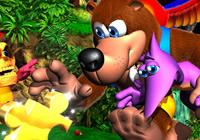
Part of the list of games that made the Nintendo 64, Banjo Kazooie is an iconic representation of the console. One of the most highly regarded and anticipated titles on N64, it saw a long and tumultuous development cycle, going through multiple makeovers like many other games on the system. First intended for the Super Nintendo under the codename Dream as an adventure game starring a young boy named Edison fighting against pirates, then moved to the N64, then made into a more action-oriented game starring a rabbit, later replaced by a bear, Banjo Kazooie saw numerous drastic changes of direction. Those could still be felt in the game to a certain extent. As a result, beyond being already highly praised for its inherent and obvious qualities, Banjo Kazooie went on to become a deep subject of research for those beta content lover archeologists, studying every little odd detail about the game, like remaining references to in-game worlds that were dropped during development (some of which, it is commonly believed, were later recycled in the sequel Banjo Tooie and Donkey Kong 64). How not to mention the unique Stop N' Swop feature which, had everything gone according to Rareware's plan, would have allowed data to be transferred to the sequel (and perhaps even Donkey Kong 64) by powering off the system, swapping cartridges fast enough and then powering it back on. Ultimately, the game we got was not the exact representation of Rare's initial vision for this project, but managed to be good enough nonetheless to be fondly remembered all those years later. Cubed3 now dives into this classic gem.
Banjo the bear lives a peaceful and carefree life on Spiral Mountain with his younger sister Tooty and a bird named Kazooie who never leaves his backpack. One day Tooty was playing outside, when she was suddenly abducted by the evil witch Gruntilda, also nicknamed Grunty. The reason is Tooty was prettier than her, so Grunty wants to use her beauty sucking machine to rob her youth and looks and become fairest of all wenches. This meagre premise, which is no worse than your typical “Bowser kidnapped Peach, blah, blah” story, sets the background to the big adventure. Banjo heads out for Gruntilda's Lair, only to be stopped by Bottles, the spectacles-wearing mole. Bottles teaches Banjo various abilities and special moves throughout the game, and unveils the first six basic moves on Spiral Mountain before Banjo and Kazooie enter Grunty's Lair, serving as an easy tutorial so the player can be at ease once stepping inside the den of evil. That or Kazooie will say outright they already know all that stuff, and Bottles will give them the moves without any further explanation, should the player decide that a tutorial isn't needed.
Once inside, the duo are not be able to progress very far because the lair is full of locked doors and obstacles that require the heroes to know certain specific moves, or the locked doors require a certain amount of music notes to have been collected.
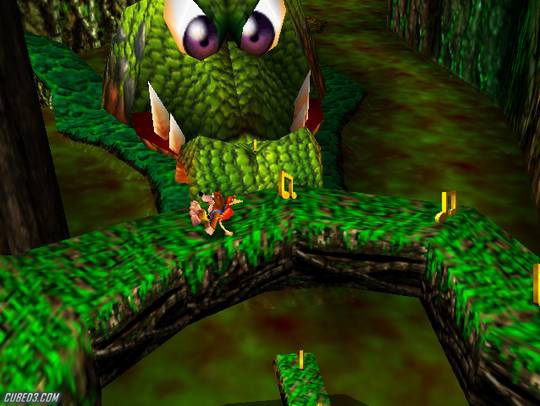
“Musical notes?” you may ask, “Where do you find those?” Inside the in-game “worlds” is the succinct response. In a Super Mario 64 fashion, Grunty's Lair, much like Peach's castle, serves as a hub world that leads to the proper “levels.” Players can access those worlds by opening doors inside the lair, which in itself requires Jiggies. The first world, Mumbo's Mountain, only requires one Jiggy, which is conveniently placed right near the entrance, and will speak to Banjo and Kazooie to explain them what Jiggies are used for; completing the jigsaw puzzles representing the different worlds, scattered around the lair, which ones completed open the door associated with it.
Each world holds 10 Jiggies and 100 music notes. The game never really requires you to collect all of them, but the requirements in both for progressing through the game ensure that players need to collect the large majority of them to see the ending. Nothing prevents progression to the next world before collecting everything in one of them, though. Every time a world is exited, the music notes gathered are not saved. The game only keeps track of the best record for each world, which means that if a world is departed from with only 99 music notes in tow, they will all need to be collected again next time, which can prove to be rather bothersome.
Overcoming specific obstacles, both in Grunty's Lair and other worlds, also requires learning new moves, requiring Bottles’s assistance in every world. Upon entering each location, Bottles will conveniently announce how many moves can be learned in that world.
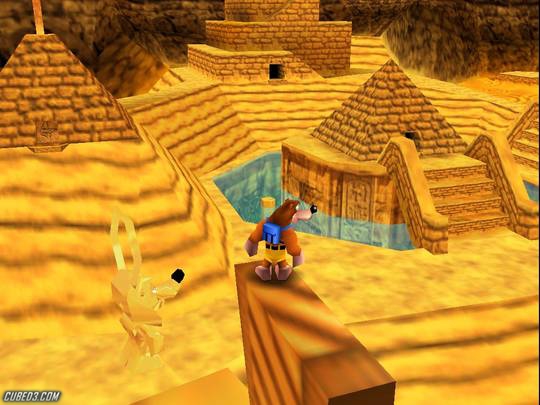
Speaking of the different in-game worlds, they are delightfully varied. Other than the generic Mario-like desert or forest stage, a polluted-port, a beach and even a haunted mansion that puts the one in Super Mario 64 to shame in terms of design will be visited. The graphics are top-notch and were the next step towards the incoming second generation of Nintendo 64 games. The usual annoying distance fog and sickeningly blurry textures are nowhere to be found (textures are still blurry, but of better quality than pretty much everything else on the system at the time). Frame-rate remains consistent throughout the game and truly helps show what can be achieved in the hands of skilled programmers.
Gathering Jiggies is as simple as just finding them and picking them up early on in the game. However, the more progress made, the more difficult collecting them becomes; more often than not requiring a lot of searching, or even conversing with Non Playable Characters in witty dialogue scenes, either leading to a battle against them, or they ask for help them with something in return for a reward. This makes the whole game a much more active and lively one than Super Mario 64 was, given the large cast of characters.
Each one has a voice of sorts, rendered as gibberish mumbles since dubbing all the dialogue would not have been feasible on a cartridge, given the limited capacity and the lack of appropriate compression and decompression tools available at the time. Those mumblings, however, do the job of conveying how the characters voice would sound.
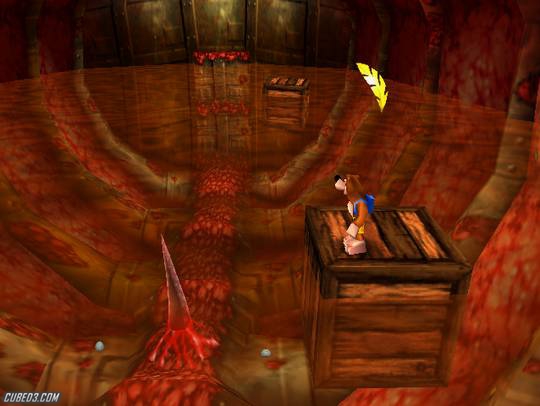
Each world also has its own music track, which in a lot of cases seamlessly switches instrument samples on the fly, depending on which area of the world the characters are currently in, giving far more variety to the soundtrack than what would otherwise be achievable within the limited data storage capacities of the cartridge format. Grant Kirkhope's compositions for this game are still among the best aural treats players’ ears have had the grace to hear in the late nineties.
As if all this wasn't a gripping enough experience as it is, loads of other items can be collected. A few examples are Mumbo's skulls which are used by the character of the same name to transform Banjo and Kazooie into a variety of different animals (an undeniable throwback to the animal friends in the Donkey Kong Country series) or empty honey combs, which are Banjo's version of heart pieces from Zelda.
To vary things even more, Gruntilda's lair doesn't just hold the levels, but It's like a giant level in itself, holding certain secrets to be uncovered and its own set of 10 Jiggies to be found, bringing the total in the game to 100, once added to the 10 to be found in all 9 worlds. Progressing through the game feels very rewarding and the light-hearted tone of this colourful adventure has arguably yet to be matched (unless you count the even more attractive sequel).
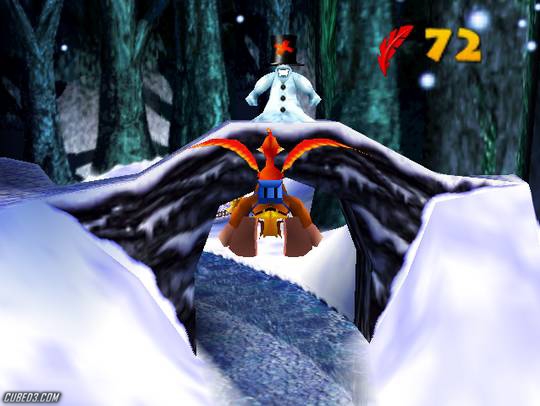
Cubed3 Rating
Exceptional - Gold Award

Super Mario 64 set the fundamentals of how a 3D platformer should be made. Banjo-Kazooie perfected the formula and brought it to a whole new level. It is filled to the brim with lovable characters, funny dialogue, brilliant gameplay and level design -- all presented using the most cutting edge graphics on a home console at the time of its release. Fast forward to 2012, the graphics do not hold as well they did back then. The fault is mainly on the mostly muddy textures that the Nintendo 64 was known for. However, the fun has not budged an inch and anyone able to look past the outdated visuals is in for one of the best designed games ever created. Modern gamers might want to go for the Xbox Live Arcade release, which smoothes the game a bit by using a 720p native resolution and higher resolution for icons, 2D objects and font. Moreover, it adds more content, like achievements and a watered down re-inception of the legendary Stop N’ Swop, finally allowing some items acquired in this game to be transferred to the XBLA release of Banjo Tooie, and vice versa. Banjo-Kazooie is a masterpiece of gaming history and a must-play for any fan of either platformers, the Nintendo 64, or Rareware itself.

![]() 9/10
9/10
![]() 9/10
(18 Votes)
9/10
(18 Votes)
 Out now
Out now  Out now
Out now  Out now
Out now  Out now
Out now Comments
Comments are currently disabled

 Sign In
Sign In Game Details
Game Details Subscribe to this topic
Subscribe to this topic Features
Features





 Top
Top

